Algorand and the Blockchain Trilemma- CryptoAcademy/ S5W4- Homework Post for @nane15
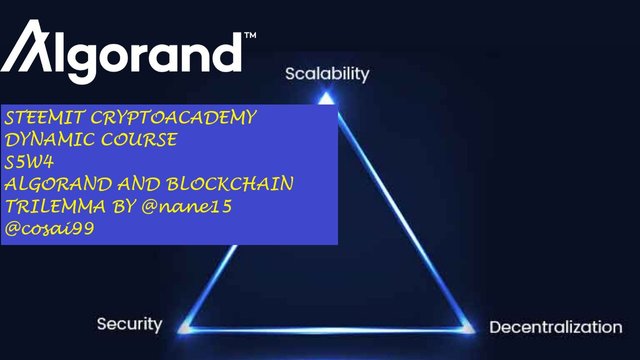.jpg)
Source
Hello, again lovely Steemians👋👋👋👋👋👋.
It's @cosai99 today with this week's homework post for the Beginners' Dynamic Course. Today, we will be talking about one of the revolutionary blockchain systems in the world today. As we know, all blockchain systems work tirelessly to improve their terms of operations and service, and this includes their consensus protocols. They continue to work on it so as to reach a very high level so all can profit from it. But as always they end up facing walls they take very long to overcome. Some even end up entirely switching to a different consensus protocol altogether just so as to make everyone happy, themselves included, and make crypto a very efficient place to make money. Today, we will talk about Algorand, the blockchain which, I believe, has been able to completely solve the blockchain trilemma that has been bothering several of the blockchain consensus protocols for a long time now. This lecture was facilitated by Prof. @nane15.
Let's take a look.
Understanding Algorand and the Blockchain Trilemma👍✔📓
Beforehand, let's explain what this Blockchain Trilemma is.
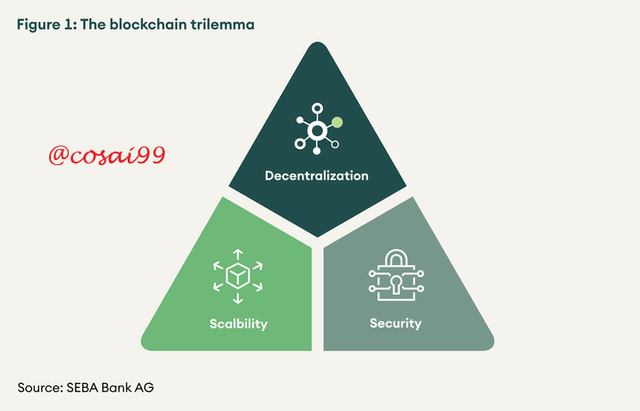
Source
The highest goal of every blockchain is concerned with three(3) things, three goals, three areas of great importance. These are Complete Decentralization, Scalability and Security. But then with the current kind of consensus protocols, none of them have been able to completely achieve all three goals. At most, only achieving two of them at the cost of the last. This is what constitutes the Blockchain Trilemma. The inability of the blockchains to achieve all the goals is basically necessary for it to serve efficient operations and services. Let's delve into what these three mean.
Complete Decentralization
This has to do with the fact that the information displayed by the block explorer is processed by all who are on the blockchain. This means that everybody must be eligible to process transaction blocks, without any costly requirements whatsoever. Take Bitcoin, for example, to be able to process blocks and mine BTC tokens, you need to have a high computing power to handle complex mathematical iterations to figure out the hashes of the blocks, which is the "puzzle" which you will be tasked to solve. It also requires a high-end graphics card to aid the CPU for processing information and also a lot of electricity since you will spend a lot of time utilizing a lot of powerful computing components. These form the minimum requirements for all systems operating on PoW consensus protocol. Again, looking at Ethereum Blockchain which uses PoS, only people who carry a lot of ETH tokens are eligible for mining blocks. Meaning that all big investors keep all such privileges leaving out those who are new to continue to struggle without earning much. This centralizes the privileges of the tycoons in such systems, making it way less decentralized as it aimed to be.
Scalability
This has to do with the number of transactions that can be processed per second. These greatly depends on the resources that must be consumed to process transaction blocks, which is also affecting the time needed to process the blocks. For example, Bitcoin again, needs a lot of electricity and computing power to process transaction blocks, which usually takes time and hence takes up to 10 minutes to process 1 block. Also, not a lot of people can afford the electricity cost or even owning a high-end computer. This doesn't make it scalable since it can't process a relatively large number of blocks in the shortest possible time.
Security
This concerns how secure and safe each block processing is. Actually, blocks are supposed to be immutable, meaning that they are almost impossible to tamper with.But with some consensus protocols, there can be ways to change somthing concerning the blocks or even reject a block that can be confirmed. This can be because there processing, validating and certification of blocks is one by either a person or a small group of people. The reason can range from the consensus style to the level of severity of the minimum requirement to process blocks. Hence, blocks can be manipulated at the will of someone.
These are the three standing blocks for the satisfying success of blockchain network.
But as I already said, it is quite difficult for the current blockchain network to achieve all three without compromising any of them. The system allows either one or two be achieved at the cost of the last, still stranded in the blockchain trillema. But then, Algorand blockchain was able to break that trilemma and achieve all three goals. Algorand is one of the newly birthed blockchain networks that run on ALGO tokens. We will talk more into details later. Now that we understand the blockchain trilemma, let's start with the task at hand.
What is Algorand blockchain?
Algorand blockchain is a blockchain network that was founded by Silvio Micali, a professor at MIT, in collaboration with Algorand Inc., which actually researches blockchain network and cryptography. They also help research into computer sciences. This was done in June, 2019 after it test launch in April, 2019. This blockchain netowork makes use of the combination of PoS and Byzantine consensus protocols to process transaction blocks in the blockchain. Like all blockchains, they make use of Smart Contracts.
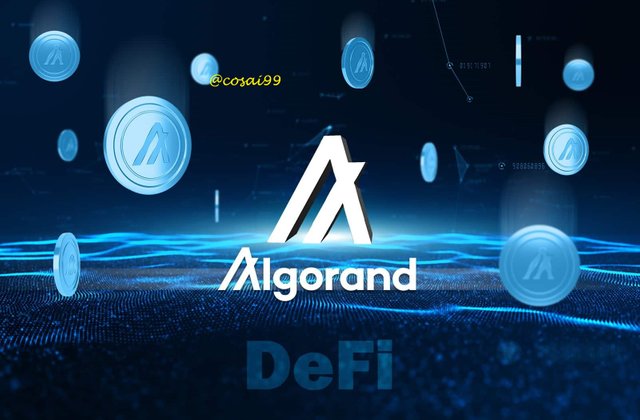
Source
Algorand block processing happens in two(2) phases, The Block Proposal Phase, and the Voting and Certification Phase.
Block Proposal Phase
This is similar to the PoS consensus protocol. Here, members of the commitee are randomly selected through a CryptographicSortition. This means that there is no central authority to decide who the users are; rather, they are selected based on the number of Algo tokens the possess randomly and also based on the type of block they want to process, all through a Verifiable Random Function,(VRF), which is a public-based pseudorandom function(meaning a public address generated cryptographically specifically for the user for use in the block processing), which serves as proof for eligibility for the block processing. The proof is kept by the user and can be presented at the will of the user. With this, the user can actively participate in the committee. After, the user presents the proposed block for verification and certification, an attached is the cryptographic proof provided by the VRF serving as eligibility for participation in block processing.Verification and Certification
This is done by the Byzantine Agreement(consensus) protocol, known as BA protocol. This is the finalization of the process. Here, through cryptographic sortition, members in the voting and certification committee are selected. There is a possibility of members in the proposal and voting anf certification committees overlapping. After, they vote on whether the block is to be accepted or not. When accepted,the block is created on the blockchain.
They use three types of smart contracts, Stateless Smart Contracts, Stateful Smart Contracts and Algogenous Smart Contracts.
Stateless Smart Contracts are those that are used for authorizing transaction processes through validation between parties. They do this by signing transactions.
Stateful Smart Contracts thereby are those which are used to store information of transactions on the blockchain. For example, when a user issues a paymet request function, information regarding the payment in a transaction is issued to a user who is been requested to make a payment, hence containing information stored about such a transaction.
Algogenous Smart Contracts acts as the brigde between thr two, acting as a convergence.
What is PPoS?
PPoS, Pure Proof-of-Stake, is a consensus protocol which is based on owning a number of tokens to be eligible for block processing. Here, all users are practically eligible to hold positions in processing and validating blocks, unlike the conventional PoS. Everyone can benefit from this as it offers complete decentralization and breaks the blockchain dilemma. This is the type of consensus mechanism that Algorand blockchain network uses, and follows the same steps which are block proposal and block verification and certification. By nature, it is a combination of the PoS and Byzantine consensus protocols so it can be said that it is similar to the original consensus protocols. The process is described above in details.
Explain the advantages and disadvantages of PPoS.
| Advantages | Disadvantages |
|---|---|
| The major advantage is that is that it is **completely** decentralized. This is because it allows opportunity for anyone to participate in block processing in whichever token they prefer, unlike the conventional PoS. Everyone is selected at random and hence there isn't any partiality in this. Also, everyone gets to participate in this so information is shared across various people acting as nodes to information and it is readily available to all. This doesn't concentrate the authority into one hands or few people. | The only disadvantage is that the system is relatively new and it is currently undergoing development and is still yet to be discovered and accepted by many more. |
| Another is that it has high scalability compared to other consensus protocols. This is because of how the the committees have been structured. There are two(2) or say three(3) different committees handling the proposal, verification and certification. Hence, with the division of labour, blocks can be processed several times faster and a huge number at the shortest possible time. Hence, it allows for more blocks to be processed. Currently, it can process 2000 blocks per second. Also, there is less stress on the system since a lot of people are involved in the block process and production operation. | |
| Again, there is a high level of security, This is due to the fact that VRF. in conjuction with cryptographic sortition is used to select committee members. The proof is in the form of cryptograph and can't be read by humans. Also, the proof can be revealed at the will of the holder. Another reason is that the users are chosen at random. So there is a low possibilty of manipulation of who gets to be in the said committee. Hence, it offers high security. The information is stored in a highly decentralized system so no one can easily tamper with information here. |
Do you think Algorand really solved the blockchain trilemma? Explain your answer.
Algorand has really solved the blockchain trilemma.
How?
Well, first is has complete decentralization in its operations in blockchain management. It has done so by broadening the margins of acceptance into the block production. Now, with this, you just have to hold the token of which you need to process the block. There isnt't any occurance of holding so many tokens just to be eligible and it is not centralized in one person just because the user has the highest possibility of producing blocks for the blockchain. So here, the concept of the rich get richer and poor get poorer doesn't work just to achieve either scalability or security. Here, all get equal opportunity as they are selected randomly.
Again, It has also very high scalability without compromising the other two. Here, due to division of labour due to the creation of different commitee being occupied by different sets of individuals allows for more blocks to be processed in the shortest possible time, and there isn't a reduced level of decentralization or security.
As these two are true, the security is high due to the fact that members of the committee are selected at random and information stored cannot be altered by anyone since it is stored by smart contracts. This is done whiles keeping the system decentralized and offering a high scalability.
This is all possible by combining the PoS mechanism with the Byzantine protocol.
Do you think PPoS is better than PoW? Explain your answer
Yes. The PPoS is better than the PoW.
This is because in PPoS, there is a high level of scalability. Comparing to PoW which cost so much electicity and computing power to process blocks and ends up consuming a lot of time due to solving complex mathematical puzzles, PPoS offers a more flexible way of requirements by just asking for users to hold tokens which they desire to process blocks for. They will be randomly chosen and then put into several committes, hence promoting division of labour which in turn reduces the amount of time needed to process blocks, as seen in PoW.
Again, decentralization is not fully achieved here since only those with enough computing power can mine blocks. This leaves a bunch of people left out in the block production process and makes those with such privileges to control the block mining process. This can also lead to a reduction in security as there is an increase potential in manipulation of the blocks.
Do you think PPoS is better than PoS? Explain your answer.
Yes again. PPoS is better than PoS. I would say PPoS is any improvement to PoS. This is because in PPoS, the the membership of the commitees are not granted to the one with the highest number of tokens held, but rather to a number of people who hold the token. Hence it promotes decentralization to a high degree. It discourages "token holding" in the blockchain as seen in PoS. This spread the opportunity to gain tokens from the top investors to several thousands of user in the blockchain. This also creates a higher scalability since it moves up the number of people involved in the production of blocks, hence, more blocks processed at a time
This brings about complete decentralization that we have envisioned in blockchain networks.
Explore and explain an ALGO transaction using algoexplorer.io ( Screenshots required)
The blocks in Algorand blockchain network can be accessed from algoexplorer.io, includint the transactions carried out. Below is the homepage.
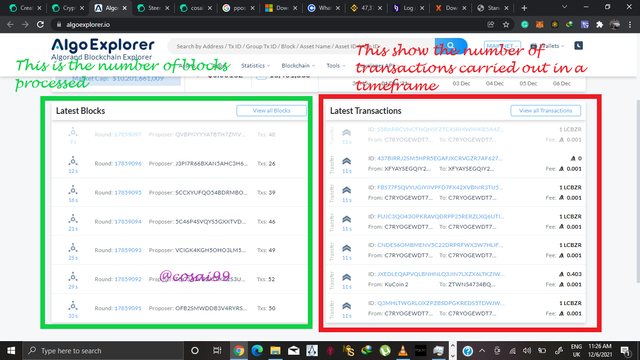.png)
Algorand Block Explorer
You can see the transactions by clicking on "View all transactions" and see all the transactions carried out with various tokens, including the one with the ALGO token having information of the amount of ALGO tokens transferred and the receiver's balance.
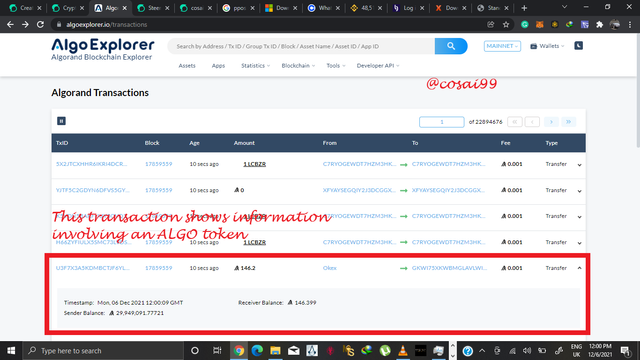.png)
Source
Carry out an analysis of the price of ALGO from the beginning of the year to the present. Via graphics (screenshots required.)
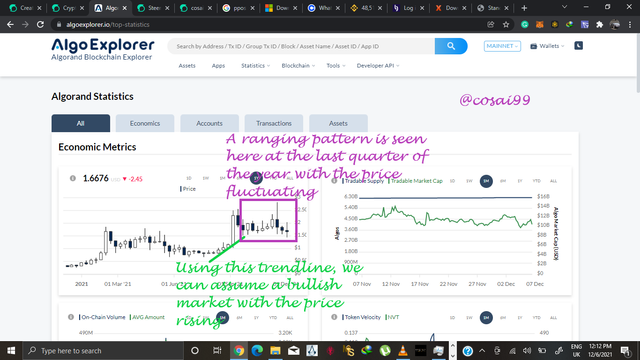.png)
Source
At the beginning, we notice a bullish trend of the market with price rising from $0.34 to $1.45 in February 17th. Then from there, we sensed a trend reversal to the bearish market in February 25th but it was a false signal and reverted to the bullish trend until April 30th when it finally reversed to the bearish trend with price dipping to $0.88.
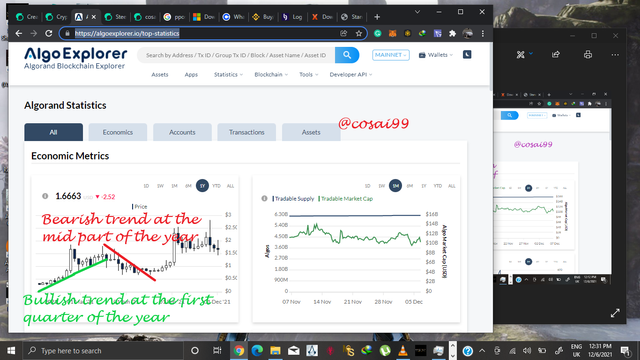.png)
Source
In the middle of the year, between July 27th and September 13th, we can assume a bullish trend in the market with price rising from $0.89 to $2.31 and entering in a ranging trend as the year closes
.png)
Source
Conclusion
Now we can appreciate the PPoS system and only hope that it comes and develops and stays as we have seen the numerous advantages it offers. Also, we can see how it makes investments in crypto easy and lucrative, serving everyone at a go. We also see how Algorand is bringing revolution to today's investment world and only hope it will continue to improve our consensus mechanism.
Thank you for reading, @nane15🙏🙏🙏🙏🙏🙏
NB: I also hope this post supports the #club5050 and is eligible to continue on the improvement it brings to the Steemit Blockchain.


HELLO 👋 friend, please verify and correct your #tag because It suppose to be "" nane15-s5week4 "" not "" nane15-s5w4 ""
Thank you friend
Prof. @nane15, could you please grade my work.
Thank you very much